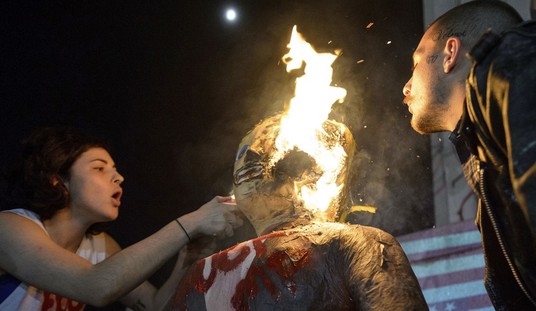SDEROT, ISRAEL – This small, working-class Israeli city on the edge of the Negev Desert, home to refugees from Muslim lands, Ethiopia, Eastern Europe and elsewhere, is world-famous for one thing only: The missiles that have rained down on it for years, fired from Hamas-controlled Gaza just a mile away.
Behind the police station, the best preserved rockets are kept in a metal-and-glass case, the kind you might use to store odds and ends in your garage. The mangled and rusted remains of scores more rest in a separate metal rack unprotected from the elements.
More than twenty types of missiles have been identified. Hamas colors its missile red and green, which gives them an almost Christmassy look. The plain red ones are courtesy of Palestinian Islamic Jihad. Yellow and red indicate the Al Aksa Martyrs’ Brigades. The black ones are from al Qaeda which also maintains a presence in Gaza. These weapons are often called Qassams but that’s a generic name that can refer to any improvised missile.
The people of Sderot have been under intermittent attack for 13 years. More than 15,000 rockets have been fired from Gaza at Israeli targets – 12,000 of those since Israel withdrew from the territory in September 2005. Those Israelis who believed that giving up all claims to Gaza would bring peace -- or at least contribute to the “peace process” -- have been proven wrong.
Israelis are often advised by foreign friends not to “over-react” to the missile attacks. Imagine if Vancouver were lobbing missiles into Seattle. How might Russians respond if Poles were shooting rockets at Moscow suburbs?
Sderot is quiet for now. The most recent conflict between Hamas and Israel ended in a ceasefire last November after the Israelis came to the conclusion that most of Hamas’ longer-range rockets, in particular the Iranian-made Fajr-5s and the Iranian-designed M-75s, had been either deployed or destroyed. The current Hamas-Israel ceasefire is the 4th in the last six years. How long it will last is anyone’s guess, though an educated guess might be that it will last until Hamas and other groups have replenished their missile stockpiles.
Recommended
Because Sderot is so close to Gaza, missile defense systems such as Iron Dome, which in November knocked out about 85 percent of the longer-range rockets aimed at population centers, cannot be used to protect the city. Instead, there are bomb shelters in apartment buildings, schools, even bus stops. When a missile launch has been detected, an alarm sounds and everyone has no more than 15 seconds to find a safe place.
Noam Bedein, who works for a regional news service, calls this a “Russian roulette reality.” He says that more than a dozen people have been killed, more than 1,500 have been seriously wounded, and just about everyone suffers to a greater or lesser extent from PTSD – Post Traumatic Stress Disorder – except there’s nothing “post” about it: the stress never ends. Despite that, Bedein says, the BBC has dismissively referred to the rockets as “primitive firecrackers.”
True, many of the missiles are not sophisticated weapons. They are made out of pipes that Israel has supplied to Gaza for such purposes as the construction of sewers. When sewage supplies run short, Hamas blames Israel, saying that Palestinians are suffering from an embargo. Many of the rockets are propelled by explosives made from fertilizer. If Gazan farmers run out of fertilizer, that, too, is said to be because Israelis are denying Palestinians adequate supplies.
Housing prices in Sderot have declined steeply since 2005 which makes it difficult for poorer residents to consider moving. The city’s population has declined but many of those who have not left say that they will not be driven out – not of Sderot, and not of Israel.
“I survived a terrorist bombing in Buenos Aires,” says Itzak Horn, an immigrant from Argentina, referring to the 1994 car-bomb attack on a Jewish community center that killed 85 people and injured hundreds more. According to Argentine prosecutor Alberto Nisman, Hezbollah carried out that bombing at the direction of Iran after the Argentinean government suspended the transfer of nuclear technology to the Tehran regime. Horn, a teacher who has lived in Sderot for five years, adds: “There is nowhere in the world that is safe nowadays. I am staying here.”

























Join the conversation as a VIP Member